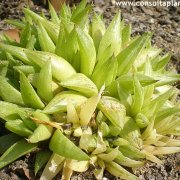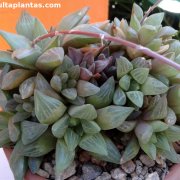Care of the succulent plant Haworthia turgida or Aloe turgida |
|
The genus Haworthia, family Asphodelaceae, comprises 100 species of succulent plants native to southern Africa. Some species are: Haworthia turgida, Haworthia truncata, Haworthia retusa, Haworthia reinwardtii, Haworthia pumila, Haworthia marumiana, Haworthia limifolia, Haworthia herbacea, Haworthia attenuata, Haworthia angustifolia, Haworthia variegata, Haworthia fasciata, Haworthia cooperi, Haworthia arachnoidea, Haworthia cuspidata, Haworthia viscosa. Scientific synonyms: Aloe turgida, Catevala turgida. This species is native to Western Cape, South Africa. They are small succulent plants that reach 10 cm (3.93") in height. The thick leaves form a rounded rosette, are 4 cm (1.57") long, erect and grayish-green or yellowish; their shape is variable and they have translucent or crystalline parts. If they receive a lot of sun, they adopt garnet tones. The flowers are very small and appear on 20 cm (7.87 ºF) long flower stalks. These easy-to-grow plants are used in pots wider than they are tall as indoor plants, greenhouses, and for balconies, windows, and patios. Haworthia turgida prefers a dim light or semi-shade exposure receiving sun in the early hours of the day. It's better not to expose it to less than 5 ºC (41 ºF). The soil can be a commercial substrate for cacti and succulents with 20% coarse sand. Water moderately in spring and summer, waiting for the substrate to dry. In autumn reduce watering a lot; in winter water once a month at most. Fertilize once in spring with mineral fertilizer for cactus diluted to half the usual dose. Haworthia turgida does not need pruning. The main enemy of Aloe turgida is excess humidity. Haworthia turgida propagates easily by separation of suckers, by leaf cuttings or from seeds. |
Images of the succulent plant Haworthia turgida or Aloe turgida |
Find plants
Haworthia turgida or Aloe turgida | Care and Growing
© 2025 FavThemes

